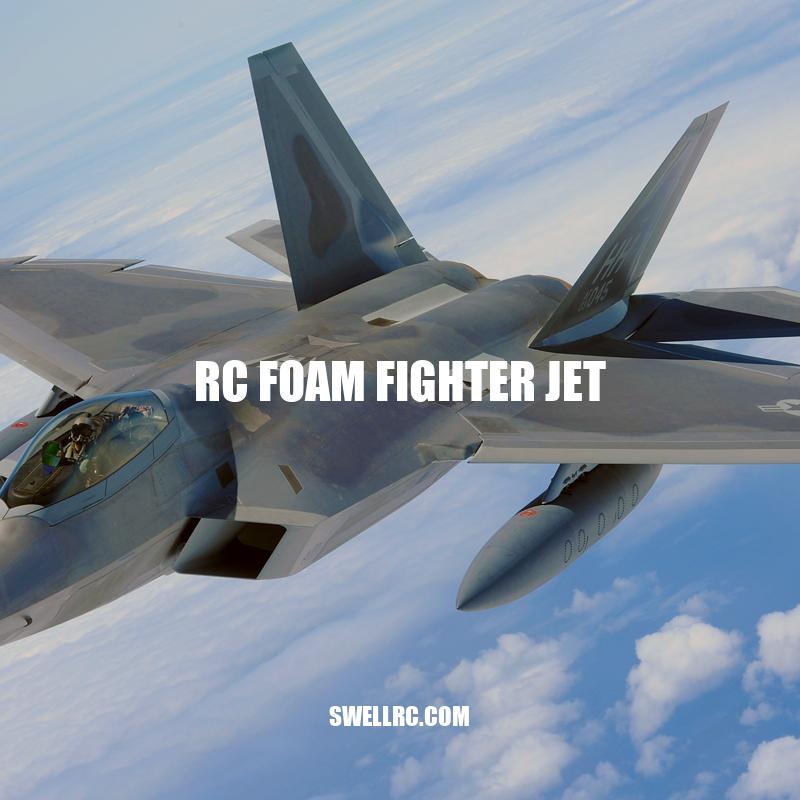Mastering RC Foam Fighter Jets: Tips, Types, and Techniques
RC foam fighter jets are gaining popularity among remote control airplane enthusiasts due to their affordability and versatility. Unlike traditional remote control airplanes, RC foam fighter jets are made of foam, which makes them lightweight and durable. They are ideal for pilots who want to learn how to fly RC airplanes without breaking the bank, or for those who want to try their hand at stunts and maneuvers. Foam fighter jets are also easy to customize and modify, allowing pilots to tailor their planes according to their preferences. Whether you are a beginner or an advanced pilot, there is an RC foam fighter jet for every skill level. In this article, we will discuss the benefits of RC foam fighter jets, the different types available, how to choose the right one, tips for building and customizing, flying and maintaining, and more.
Benefits of RC Foam Fighter Jets
RC foam fighter jets come with a number of benefits that make them a great option for remote control airplane enthusiasts. Here are some of the benefits of using these planes:
- Cost-effective alternative to traditional remote control airplanes.
- Can be easily modified and customized according to your preferences and skill level.
- Lightweight and durable, making them ideal for performing stunts and maneuvers.
- Less prone to damage in case of crashes, making them ideal for beginners.
- Less noise pollution compared to traditional remote control airplanes, allowing you to fly them without disturbing your neighbors.
- Wide variety of designs and models available, including F-16, F-18, and SU-27 among others.
Despite the number of benefits they have, most RC foam fighter jets available in the market are inexpensive. Brands like E-flite, Great Planes, and HobbyZone offer a range of RC foam fighter jets for hobbyists. If you want to learn more about RC foam fighter jets or would like to purchase one, there are plenty of websites like Tower Hobbies, Motion RC or Horizon Hobby that offer a range of options and information to help you get started.
What are the advantages of RC planes?
Flying and building RC planes can be a fun and rewarding hobby. Not only does it provide a great way to unwind and relax, but it also helps in developing skills such as patience, attention to detail, and problem-solving. Additionally, RC planes can fly at much lower altitudes and in smaller spaces compared to real planes and can be operated by remote control, making it safer and more cost-effective. Visit websites like HorizonHobby.com, RCPlanet.com, or TowerHobbies.com for more information on RC planes and their advantages.
RC foam fighter jets are an exciting hobby for enthusiasts who enjoy flying and piloting remote-controlled aircraft. There are several popular types of RC foam fighter jets to choose from, each offering a different flying experience.
Some popular types of RC foam fighter jets include the F-16, F-18, and SU-27. The F-16 is fast, maneuverable, and typically has a large wingspan, allowing for stunning aerial moves. However, it may require advanced piloting skills to operate. The F-18 is known for agility and speed, providing a more realistic flying experience. However, it may require more maintenance compared to other types of RC foam fighter jets. The SU-27 offers an excellent balance of speed, agility, and stability, making it a great option for novice and expert pilots. However, it may require a higher level of investment than other types of RC foam fighter jets.
There are also other types of RC foam fighter jets available, such as the F-14, JetEngine, and HawkEye. Each model differs in design, speed, and maneuverability, offering a thrilling flying experience.
If you’re interested in purchasing an RC foam fighter jet, several websites offer a range of options. You can visit sites like Banggood, AliExpress, or Amazon to find the model that’s right for you.
What are the different types of RC plane foam?
There are several types of foam that are used for RC plane manufacturing. The main foam types used are Expanded Polystyrene (EPS), Expanded Polypropylene (EPP), Expanded Polyolefin (EPO) and Depron. Each foam type has its own strengths and is used for specific applications. Foam RC airplanes are extremely durable. For further information on RC planes, you may visit websites such as rcgroups.com or horizonhobby.com.
Choosing the right RC foam fighter jet
Choosing the right RC foam fighter jet can be a daunting task, especially for beginners. Here are some factors that you need to consider when choosing an RC foam fighter jet:
- Skill level and experience: The level of experience and skills of the pilot significantly affects the choice of foam fighter jet they opt for. Beginners should choose an RC foam fighter jet with stable flight characteristics and easy-to-control maneuvers.
- Size and weight: The size and weight of the RC foam fighter jet affect its flying performances. A larger foam fighter jet is more stable and easier to fly than a smaller one, but it typically has a lower speed. Smaller foam fighter jets are more agile and maneuverable, but require greater piloting skills.
- Motor Power: An RC foam fighter jet with a high motor power concerns greater speed and better maneuverability.
- Brand and Model: Different brands and models have various features and ease of control that may align with the pilot’s needs and flying style.
Some excellent RC foam fighter jets that are suitable for beginners include the ParkZone F-27C Stryker, E-flite Pawnee Brave Night Flyer, and Hitec Sonic 500. For intermediate to advanced pilots, the E-flite F-18 Hornet 80mm EDF and Freewing F-16C Super Scale Thunderbirds are excellent options. Several websites such as Amazon, Horizon Hobby, and Motion RC offer a wide range of RC foam fighter jets to choose from.
Which foam is best for RC planes?
Depron is a popular choice for thinner insulation foam that can be curved for smaller RC planes. EPP foam is a flexible alternative for indoor ready-to-fly RC planes. For heavier electric-powered RC planes, foam board and Blucor Fanfold foam are utilized. More details and product options can be found on relevant websites.
Building and customizing an RC foam fighter jet
Building and customizing an RC foam fighter jet can be a fun and creative experience. Here are some tips for building and customizing your very own RC foam fighter jet.
- Choose the right materials: Some essential building materials for an RC foam fighter jet include foam board, glue, paper, and paint. You can buy these materials from your local craft store or hobby shop
- Find the right plan: You can find free RC foam fighter jet plans and templates online. Just download and print the plan of your choice and start building from there.
- Add decals and paint: Adding decals and paint can make your RC foam fighter jet more attractive and aesthetically pleasing. You can also personalize your RC foam fighter jet with your custom paint scheme or decals.
- Upgrade parts: You can improve the performance and speed of your RC foam fighter jet by upgrading motors, propellers, and ESCs. Some online stores such as Hobby King and Horizon Hobby offer a wide range of parts you can buy and upgrade your RC foam fighter jet.
If you’re not comfortable building an RC foam fighter jet from scratch, you can purchase ready-to-fly models that come with full directions and are easy to put together. Some popular ready-to-fly models include the E-flite F-15 Eagle BNF and the Freewing 80mm EDF F-14 Tomcat.
Several websites such as Flite Test, RCPowers, and RCGroups offer plenty of resources, tips, and tricks for RC foam fighter jet building and customizing.
Can you paint a foam RC plane?
Yes, you can paint a foam RC plane with water-based acrylic paint. Solvent-based paints can dissolve the foam, so it’s best to avoid them. You can find acrylic paint at various stores, such as Michaels and Wal-Mart. For more information on painting foam RC planes, you may want to check out Foamflyer’s RC Airplanes website or visit the Foamcore Wikipedia page.
Flying an RC foam fighter jet can be a thrilling experience, but it’s important to know how to fly safely and maintain your RC foam fighter jet to keep it in top condition. Here are some tips to get you started.
Pre-flight checklist and safety procedures
- Inspect your RC foam fighter jet for any damage or loose parts before each flight. Check the control surfaces for proper movement and make sure the battery is fully charged.
- Find an open area with no obstacles, people, or animals nearby to fly your RC foam fighter jet safely.
- Always fly within the line of sight and avoid flying near airports, power lines, or restricted airspace.
- Apply necessary safety measures like wearing safety goggles and gloves to avoid any kind of injuries during the flying of RC foam fighter jet.
Best practices for piloting an RC foam fighter jet
- Start with easy maneuvers, such as taking off, flying in a straight line, and making gentle turns.
- Gradually try more complex maneuvers such as rolls, Loops and Immelmann turns when you feel comfortable with the jet’s responsiveness and control.
- Practice landing your RC foam fighter jet before attempting any stunts, as it can help you avoid crashes or damage to the jet.
- Keep an eye on the battery level and make sure to bring your RC foam fighter jet back to the ground safely before the battery power runs out.
Tips for maintaining and repairing an RC foam fighter jet
- Clean your RC foam fighter jet after each flight using a soft cloth or brush to remove dirt and debris.
- Replace broken or damaged parts immediately before attempting to fly again.
- Store your RC foam fighter jet in a dry and cool place to prevent damage from moisture and extreme temperatures.
- Refer to manufacturer instructions or online tutorials for repair and maintenance techniques.
Several websites such as Flite Test, RCPowers, and RCGroups offer plenty of resources, tips, and tricks for flying, maintaining, and repairing RC foam fighter jets. You can also find replacement parts and accessories online stores such as Hobby King, Motion RC, and Horizon Hobby.
How do you protect a foam RC plane?
One way to protect a foam RC plane is to apply a clear coat of spray paint or polyurethane. This will help to prevent scratches and dings from damaging the foam. Additionally, always transport the plane in a sturdy case or box to prevent damage during transport. For more detailed instructions and tips, check out the video tutorial by Flite Test on YouTube: https://www.youtube.com/watch?v=P-YhPdAeHBM.
Conclusion
Flying an RC foam fighter jet can be a thrilling experience for beginners and experienced pilots alike. With proper preparation, practice, and maintenance, you can easily build and customize your own RC foam fighter jet and enjoy performing stunts and maneuvers with ease.
Whether you are a hobbyist or a competitive pilot, the world of RC foam fighter jets offers endless opportunities for creativity, learning, and fun. Don’t be afraid to experiment with new designs or techniques, and always prioritize safety when flying.
With a wide selection of types and brands available, you can find an RC foam fighter jet that suits your skill level and interests. Browse online resources and stores for inspiration, support, and community in the world of RC foam fighter jets.
So what are you waiting for? Get ready to soar through the skies and experience the thrill of RC foam fighter jets!



